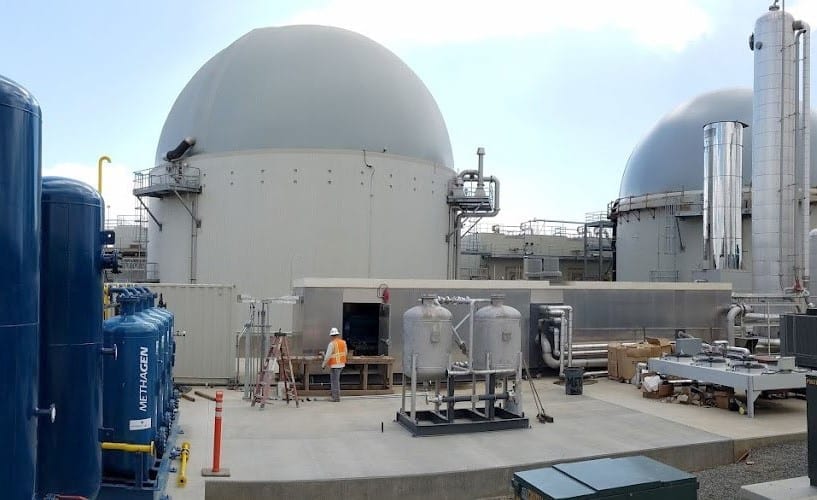In early July 2018, renewable natural gas (RNG) began to flow into Southern California’s natural gas distribution system from a state-of-the-art high solid anaerobic digester (HSAD) in Perris, California, that processes organic waste that would otherwise have been sent to a landfill. Because the waste will no longer have an opportunity to naturally decompose at a dumpsite and emit harmful greenhouse gases (GHGs), the RNG being produced and delivered into the pipeline has a negative carbon profile. This first-of-its-kind project was made possible by the innovation, investment, and commitment of CR&R, a leading waste and recycling collection company.
The CR&R project promises to be the first of dozens of similar such projects in our state over the next decade, given California’s strict new policies related to the reduction of GHGs, diversion of organic waste from rapidly filling landfills, and decarbonization of its energy supply.
From Waste to Renewable Natural Gas
Well known to those familiar with bioenergy and innovative waste management in the U.S., the CR&R anaerobic digestion facility is at the vanguard of an emerging trend to reduce greenhouse gases and more sustainably manage municipal refuse.
The intrinsic value of CR&R’s natural gas is that it is 100% renewable as it is produced as a matter of course from the normal daily activities of the tens of thousands of residents whose waste food, grass clippings and other organic garbage would otherwise be dumped in local landfills.
CR&R’s facility, in Perris, CA, takes food and green waste from more than a dozen cities throughout Southern California, processes it (i.e. sorts through the material to remove all plastics, metals and other inert material), grinds it, and dumps the refined material into digesters. There the organic mix will sit for about a month, consumed by voracious microbes that are optimized to consume the organic matter, reduce its mass, and convert about half of it to carbon dioxide and methane. The methane is then sucked out of the digesters, cleaned to pipeline quality natural gas – that is pretty much indistinguishable from natural gas from fossil sources – compressed and injected into a nearby gas distribution line. CR&R then consumes the RNG that it produces in the very trash trucks that pick up the organic garbage from the company’s customers.
The intrinsic value of CR&R’s natural gas is that it is 100% renewable as it is produced as a matter of course from the normal daily activities of the tens of thousands of residents whose waste food, grass clippings and other organic garbage would otherwise be dumped in local landfills.
This distinguishes the renewable natural gas that CR&R creates from conventional natural gas because it simply recycles carbon that is already in the biosphere. This is a critical distinction from “fossil” natural gas, because it involves the release of long sequestered carbon that has been segregated from the surface ecosystem for eons in the crust of the earth. It is because of fossil gas’ ancient nature – the exploitation of which involves the liberation of hydrocarbons that were once prehistoric plants and animals long buried beneath the surface of the earth – that causes it to be one of the contributing factors of climate change. However, if carbon already circulating in atmosphere is recycled, and contemporary methane that would have lofted in to the atmosphere from a landfill is captured and diverted to replace fossil diesel or natural gas, the benefit to the climate is substantial.
CR&R’s project may be the first, but it is highly unlikely that it will be the only. The principles of sustainability require that society reduce, recover, and recycle waste, particularly organics.
If the project wasn’t enough of a gamechanger, CR&R uses the negative carbon RNG it produces from garbage in trash collection trucks that are being equipped with the near-zero-emission Cummins natural gas engines. As discussed in ACT News previously, these engines emit levels of smog-forming pollutants so low that they are amazingly four to nine times cleaner than electric trucks of comparable size charged by power from the California grid.
The First, but Not the Last, Project of Its Type
CR&R’s project may be the first, but it is highly unlikely that it will be the only. The principles of sustainability require that society reduce, recover, and recycle waste, particularly organics. It is essential for communities that purport to be environmentally conscious to integrate programs to divert, capture and reuse resources, particularly as a substitute for raw materials that are finite. In addition, as policymakers make decisions where to spend the state’s finite resources, it is important to use these funds to accomplish multiple social goals, such as reducing emission not only of climate changing pollutants, but reducing the exposure of vulnerable communities to smog and toxic air contaminants, such as diesel exhaust. It is critical that the state use the resources that it collects in the Greenhouse Gas Reduction Fund (GGRF) to fund the development of projects like CR&R’s Perris plant, as well as the purchase and use of vehicles that will consume the RNG produced by the recycling and reuse of our organic wastes.
A recent study from the International Resource Panel (IRP), part of the UN Environment Programme found that humanity has tripled its extraction of raw materials from the earth since 1970, from 22 billion tonnes to over 70 billion tons in 2010, an alarmingly unsustainable rate of consumption. “The alarming rate at which materials are now being extracted is already having a severe impact on human health and people’s quality of life,” said the IRP’s co-chair, Alicia Bárcena Ibarra, a Mexican biologist who also serves as the Executive Secretary of the United Nations Economic Commission for Latin America and the Caribbean. It is critical for California to do its part, by helping communities all over the state and country study understand what CR&R is doing so that it can be replicated, helping to further reduce our dependence on finite fossil fuels and landfilling our waste.



